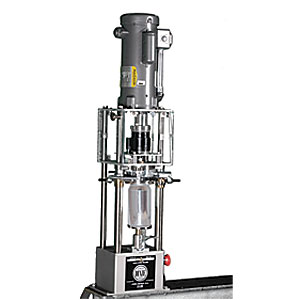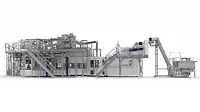Can filling industry keeps up with can style changes
Seamers incorporate changeparts to accommodate different can sizes
As Disney’s “Toy Story 3” movie portrays, children’s interests in toys change as they grow up. Similarly, as the beverage can industry matures, its interest in packaging sizes changes. These changes have a domino effect on the equipment that fills and seams these cans.
“In the old days, there was primarily one beverage can — a 12-ounce can,” says Bob Pease, director of wet-end group products for KHS USA Inc., Waukesha, Wis. “Billions of the cans were the same size [in terms of] diameter, height, end size, etc., so the machines physically did not [need] changeover.” However, more than 50 years after the launch of beverages in cans, the market is flooded with varying can sizes, changing the can’s dimensions by height, diameter and even material thickness.
Nowadays, manufacturers are constantly creating new can sizes to fit more of them on the truck, better utilize shelf space at retail, improve production efficiency, and create a better drinking experience for consumers, notes Chris Stapleton, one of the managing partners of Athens, Ga.-based Dixie Canner Co. To uphold the filling and seaming standards established for the traditional can size, can filling and seaming equipment has had to increase its flexibility and evolve with the growing beverage can market.
The first packaging development in can dimensions revolved around different can heights, KHS USA’s Pease says. The diameters and seams of these cans were the same as the 12-ounce cans, but the filling machines had to be raised and lowered to accommodate the new heights. Therefore, the mechanisms that adjust the heights on the machine had to be overhauled, he explains. Today, the height adjustment mechanisms are designed to run frequently, and they automatically exercise the machine’s vertical movement so that the machine does not become frozen in any vertical position, Pease says.
On the seaming side of beverage can packaging, accommodating different can heights is accom-plished through the use of change parts, Dixie Canner’s Stapleton explains. He suggests that beverage-makers choose a seaming machine that can accommodate the tallest can size they plan to use and adjust for smaller heights by using a baseplate. These baseplates raise the can to help it reach the chuck and can be changed in seconds without tools, he notes. Height spacers also can be used for major differences in height, he adds.
However, when the 6-inch-tall energy drink cans hit the market, PneumaticScaleAngelus (PSAngelus) designed special seamers to process the different can size. “They present a special challenge, since the end is very tall, which affects the lifter cam stroke as well as requires special end-handling to feed the ends of the seamer,” explains Jeff Bernstein, director of seamer engineering for the Stow, Ohio-based company.
After height changes came different can diameters, KHS USA’s Pease explains. This requires change parts for both the filling and seaming machines. KHS USA uses tool-less, lightweight change parts that can be interchanged to adapt the machine to different can diameters, Pease says. Specifically for its Innofill DVD can-filling machine, KHS USA offers replacement upper back rests for processing cans of various diameters, he says. However, because its centering tulips offer multi-diameter sealing, these pieces do not need to be changed for different can diameters, he adds.
Seaming machines, however, require a few more change parts. For each can diameter, seaming machines require specialized first- and second-operation seam rolls to properly apply the double seam, Dixie Canner’s Stapleton explains. In addition, the different can sizes require custom base plates and chucks to hold the can in place while still allowing it to spin freely to apply the seam without scuffing the can, he adds.
The lighter side
More recently, filling and seaming machines have had to adjust to accommodate lightweight cans. For this packaging evolution, it’s all about gentle handling, says Barry Fenske, product manager for Franklin, Wis.-based Krones Inc.’s filling division. “For the filler, we make adjustments to the filling valve descending down onto the can to make sure we don’t damage the cans,” he explains. In addition, it is important to test some filled samples to make sure there are no packaging or filling issues, he adds.
This gentle handling is especially important for seaming machines, says Michael A. Mangone, managing member of Shoreline Packaging and Processing Machinery LLC, Havre de Grace, Md. “Lightweighted cans are particularly difficult to seam properly at high speeds without damaging or wrinkling the thin can walls,” he explains. “Extra precautions need to be in place for the can-handling parts.”
Such extra precautions can include using can-handling change parts equipped to handle lightweight cans and ensuring that the seamer pieces are in optimal running condition to ensure that the can is seamed correctly without denting the can, PSAngelus’ Bernstein says.
Leveling up
Once the machines are equipped to accommodate the desired can sizes and tolerances, fillers need to ensure that the machines are dispensing the correct amount of liquid into each can. Technology makes this fairly easy for the machine operator, Krones’ Fenske says. “Each can package has its own recipe, so all the filling parameters specific to each package are stored in the [programmable logic controller] (PLC) and easily called up at the [human-machine interface] (HMI),” he says. “That way, you can optimize the filling and the [cans per minute] (CPM) for every product type and every can size.”
To ensure that the filling recipes are carried out properly, Krones’ filling machines use volumetric filling valves with electro-pneumatic controls, Fenske says. Each valve has a flowmeter that accurately measures the amount of product dispensed into each can, he explains. By incorporating inspection machines, the equipment can double-check the fill level after seaming, he adds. These routine inspections can identify filling problems that can be corrected in the system to avoid future waste, he says. “If necessary, we can make adjustments on the fly through the HMI to get the valve where it needs to be,” he explains.
Volumetric flowmeters are much more accurate than the previously used fill-to-a-level method, KHS USA’s Pease says. With filling-to-a-level, cans were filled with an accuracy of plus or minus 1 mm, while volumetric filling fills cans with an accuracy of plus or minus 1 ml, he explains. This former 1 mm threshold is three times that of today’s 1 ml volumetric threshold, he notes. “It sounds like not very much, but over the course of a year, if you’re running 1,000 or 2,000 cans per minute of valuable beverages like [juice drinks] or beer, it adds up to a lot of money,” he says.
Although fill-height accuracy is important to beverage categories across the board, the juice category especially seeks filling machines with high filling accuracy, Pease says. Juice products are typically expensive, and therefore, the category is very interested in reducing or avoiding product loss at all costs, he explains.
Filling accuracy also is important in the beer industry because it goes hand-in-hand with low oxygen pickup, Pease notes. Because beer is a perishable product that is sensitive to oxygen, can fillers for beer need to control the fill-level of the can to minimize headspace in the can, he explains. More headspace corresponds to more opportunities for oxygen pick-up, which can threaten the shelf-life of the beer, he says. This is especially important for the craft beer industry, which is trending toward not pasteurizing the beer before filling, he adds. As such, beverage can fillers want to fill the can as high as possible without spilling in order to reduce oxygen introduction and avoid wasting valuable product, he says.
Beyond filling accuracy, can-filling technology also is helping to fill cans more cost-effectively through temperature control, Pease says. Although carbonated soft drinks are generally cold-filled, new filling technology is making it possible to fill the cans at ambient temperatures, he says. When cans are filled cold, condensate can form on the outside of the cans, he explains. This moisture can damage the secondary packaging and cause mold growth, he says. To avoid this, can fillers would have to run the cans through a large can-warmer tunnel that sprays warm water on the cans to eliminate the condensate, he explains. This requires a significant amount of warehouse space plus costs to use and warm the sprayed water, he says. Through ambient filling, can fillers are able to reduce these costs, eliminate their product refrigeration costs, and fill a more stable beverage, he adds.
Although it’s hard to tell how can sizes will change in the future, it looks like can fillers and seamers will be equipped to handle the changing interests of consumers as time elapses.
Looking for a reprint of this article?
From high-res PDFs to custom plaques, order your copy today!




